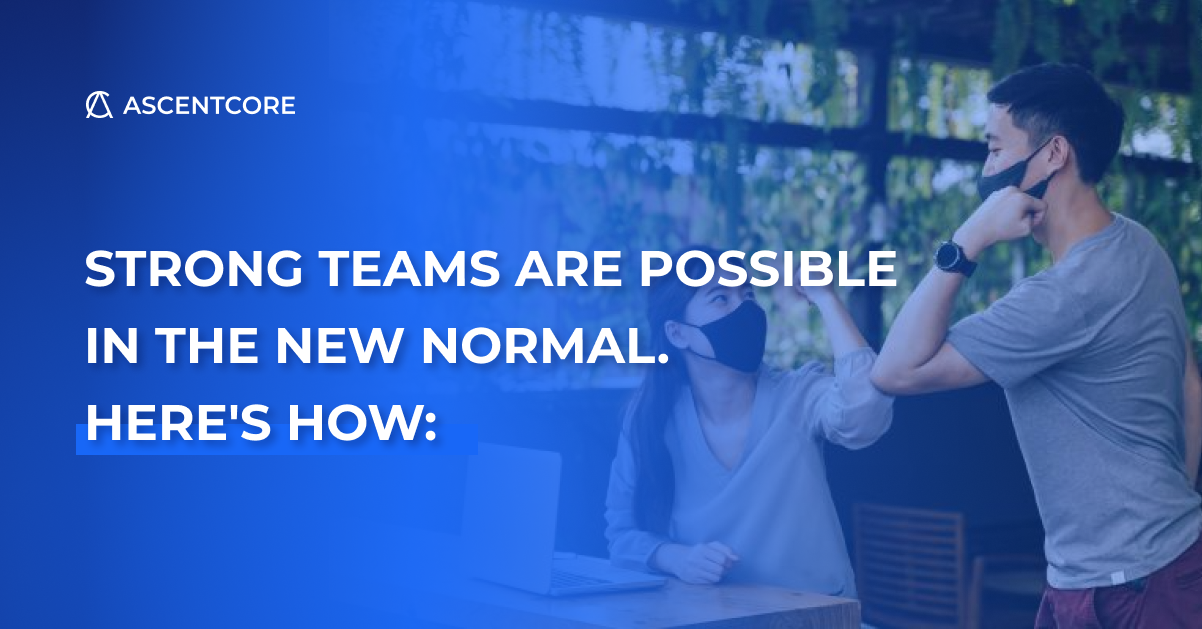The COVID pandemic presented the world with a slew of unprecedented challenges that have affected every aspect of life – from remote learning and teaching to socially distanced events and working from home. Without a doubt, society has risen to these challenges and created solutions that will most likely follow us into the future, even post-pandemic. In the business world, one challenge leaders have grappled with is how to motivate and build cohesive teams in the new normal of remote staff, video meetings, and social restrictions.
At AscentCore, this challenge has been top of mind and we’ve been collaborating internally to share best practices and lessons learned to make sure our teams have what they need to do their best work – and be happy – during uncertain and changing times. We sat down with Ionut Gavris, Senior Technical Manager at AscentCore, for his take on how to lead and manage teams during (and after) the pandemic.
Nurturing a team virtually
One of the biggest challenges facing businesses has always been effectively growing and nurturing a team – even before the pandemic. Ensuring that you don’t grow too fast and burn out, keeping different personalities aligned and cohesive, and making sure everyone is working toward the same goal are just a few examples of growing pains. The added complexity of entire companies working remote (and in some cases, staff never meeting face-to-face) has made this even trickier.
Ionut looked to his experience managing a client project where he was able implement changes that helped his teams move faster and work better together, including:
- Closing the time zone gap: One major obstacle for companies with remote staff all over the world is time zones. Between the client and AscentCore, staff were located all over the world – from the US to Europe. As a result, Ionut saw projects slow down because teams would have to wait a day or two to get what they needed from a colleague who may already be off the clock in a later time zone. So he decided to restructure the teams to work together in closer time zones. In doing so, he was able to speed up coding and production time, and ease some of the pressure on staff who were getting up early or working late to accommodate time differences. In a time when the lines between work and home life are increasingly blurry, this is critical to productive and happy teams.
- Frequent meetings: One of the most widespread effects of the pandemic has been loneliness, as social restrictions prohibited virtually all in-person contact. And with much of the office workforce still working from home, mental health challenges and feelings of isolation are all too real. Ionut worked with both internal staff at AscentCore and the client to mitigate the effects of social isolation. This included weekly coffee meetings, regular check-ins to talk about work (and anything else needing attention), and bi-weekly one-on-one meetings. The high frequency of meetings was not something managers typically do at AscentCore, but Garvis saw that it was important to prioritize “face time” during the pandemic – both for productivity and the mental well-being of his staff and client.
- Intentional onboarding: Many companies have an onboarding process for new employees that includes meet and greets, coffee meetings, and detailed orientation sessions that help new staff feel welcome and acclimated. But how do you recreate that when everyone is at home? Ionut decided that every new employee would get a “buddy” to answer any questions and act as a mentor. The buddy would also help ensure that the new employee was up and running on their project and ready to meet their deliverables. On this project, he was able to create an almost 50/50 mix of AscentCore and client staff. So a new AscentCore employee might have a client buddy, and vice versa, creating a unique connection that may not have existed before the pandemic.
- Know when to ask for help: A good problem for any business to have is a quickly growing team. But this can also hamper progress in creating cohesive and productive teams. Ionut found himself in this situation when he knew the team was too big to handle on his own. Since continuing with the status quo would have made it hard for him to maintain the frequent meetings and buddy system that had been working so well, he got help. He hired a second manager to help cover some of his responsibilities and ensure that the teams still received the one-on-one guidance they needed. It also helped the leadership team understand what was going on with the entire project at all times, and helped spread out responsibilities so everyone could take time off without slowing down the work.
Different times call for different action
The pandemic, and its many effects on the entire world is truly unprecedented. It has required agility, patience, and experimentation to navigate the challenges while still keeping society running. For employers and employees, previous ways of operating routines have been upended, requiring us to create a new normal as it’s happening. It is still possible – and critical – to build and grow well-oiled, effective teams of motivated, happy employees during this time. Managers must dig deep and think of different ways to grow their teams by identifying challenges and finding innovative solutions such as bridging team divides, intentional onboarding, and asking for help. Ionut and his team at AscentCore proved that building a motivated team is possible during the pandemic, and will carry these learnings far beyond this crisis to create even stronger teams for their clients.



